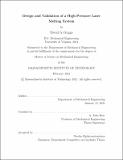| dc.contributor.advisor | A. John Hart. | en_US |
| dc.contributor.author | Griggs, David A.(David Andrew) | en_US |
| dc.contributor.other | Massachusetts Institute of Technology. Department of Mechanical Engineering. | en_US |
| dc.date.accessioned | 2021-05-25T18:23:16Z | |
| dc.date.available | 2021-05-25T18:23:16Z | |
| dc.date.copyright | 2021 | en_US |
| dc.date.issued | 2021 | en_US |
| dc.identifier.uri | https://hdl.handle.net/1721.1/130854 | |
| dc.description | Thesis: S.M., Massachusetts Institute of Technology, Department of Mechanical Engineering, February, 2021 | en_US |
| dc.description | Cataloged from the official PDF version of thesis. | en_US |
| dc.description | Includes bibliographical references (pages 121-124). | en_US |
| dc.description.abstract | Metal additive manufacturing (AM), and in particular, laser powder bed fusion (L-PBF), is being successfully applied to diverse industrial applications. However, L-PBF demands a thorough investigation of the complex thermophysical phenomena which occur where the laser interacts with the metal powder bed. Studies of both L-PBF and laser welding show that gas dynamics, and therefore the ambient pressure, significantly impact the process and the quality of resulting parts. This thesis is motivated by an interest to investigate L-PBF at elevated ambient pressure, with the central hypothesis being that elevated pressures may decrease vaporization and melt pool turbulence, resulting in more uniform melt tracks, and thus, higher quality L-PBF parts. Therefore, this thesis presents the design and validation of a custom built high-pressure laser melting (HPLM) system which accommodates bare metal plate samples as well as manually-coated single powder bed layers. The open architecture of this testbed allows for full dynamic control of all relevant laser parameters in addition to ambient gas pressure and gas flow over the build area. Representative melt tracks and rasters on bare plate and powder are examined in order to validate system performance. Preliminary analysis concludes that pressure has a significant impact on melt pool aspect ratio and on the total amount of material melted, and that the HPLM system is capable of precision investigation of laser melting and L-PBF at pressures of up to 300 psig, considering both machine operation and gas flow dynamics. The HPLM system thus enables careful study of pressure's influence on the process windows of common L-PBF materials as well as materials that are challenging to process under ambient pressure, such as those with high vapor pressures. | en_US |
| dc.description.statementofresponsibility | by David A.Griggs. | en_US |
| dc.format.extent | 124 pages | en_US |
| dc.language.iso | eng | en_US |
| dc.publisher | Massachusetts Institute of Technology | en_US |
| dc.rights | MIT theses may be protected by copyright. Please reuse MIT thesis content according to the MIT Libraries Permissions Policy, which is available through the URL provided. | en_US |
| dc.rights.uri | http://dspace.mit.edu/handle/1721.1/7582 | en_US |
| dc.subject | Mechanical Engineering. | en_US |
| dc.title | Design and validation of a high-pressure laser melting system | en_US |
| dc.type | Thesis | en_US |
| dc.description.degree | S.M. | en_US |
| dc.contributor.department | Massachusetts Institute of Technology. Department of Mechanical Engineering | en_US |
| dc.identifier.oclc | 1252630570 | en_US |
| dc.description.collection | S.M. Massachusetts Institute of Technology, Department of Mechanical Engineering | en_US |
| dspace.imported | 2021-05-25T18:23:16Z | en_US |
| mit.thesis.degree | Master | en_US |
| mit.thesis.department | MechE | en_US |
